by jgl1 | Mar 1, 2013
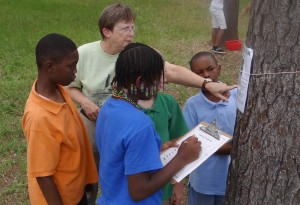
“Our 4-H volunteers strive to provide a positive learning experience for all youth, reassuring parents that their children are in safe and nurturing environments, but what do you do when you recognize child abuse? How do you deal with it?”
As members of a youth serving organization it is important that adults are aware of their responsibility for child safety. Our hope is that all children will live in a safe environment, but we know that children are exposed to neglect and abuse. We have a responsibility to educate ourselves and the children with whom we work about the risks to the welfare of a child. It is mandated by law as a volunteer with the Florida Cooperative Extension Service that you must report suspected child abuse cases to your Florida Department of Children and Families. (more…)
by Whitney Cherry | Feb 21, 2013
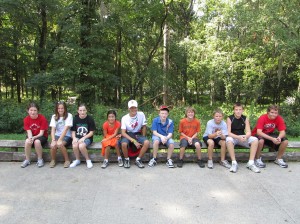
It is important to ensure that our programs are open to everyone.
Federal affirmative action guidelines require that a 4-H club’s membership reflect that of the community which it serves. So, if your club serves the whole county, and your county is 54% white 36% black, 6% Hispanic, and 3% other, then your club membership should be 54% white 36% black, 6% Hispanic, and 3% other. However, this is not always the case. In such instances we use All Reasonable Efforts (ARE) to show that we are making our clubs available to everyone. (more…)
by Yolanda Goode | Feb 18, 2013
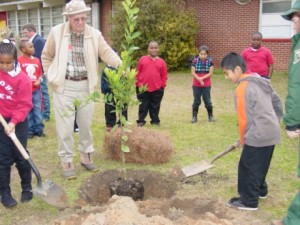
4-H’ers celebrating a National Day of Service in January.
February has long been associated with heart related events. Of course, there is Valentine’s Day, a day of love. Additionally, the full month is devoted to a focus on heart health. Continuing on this heart related theme, I want to focus on generosity. Generosity is one of the four essential elements for youth development. It is valuing others and serving them. Sincere generosity involves the heart and is usually demonstrated with the use of the hands. Incidentally, these are two of the four H’s of the 4-H Youth Development program.
As 4-H volunteers we strive to teach youth to be generous. Service is a good way for youth to learn generosity. By providing opportunities to connect with their communities through service, we help youth develop generosity and find meaning and value in their lives. This can be accomplished by helping youth realize the full impact of their efforts.
Often, through asking questions we can help youth see the big picture. Asking questions can cause them to see what is beyond the immediate actions of service such as getting out of bed early and giving up some time to rake leaves. Helping them see it’s more than just logging service hours for school, awards or scholarships may help them get to the heart of the service they’ve performed.
Questions you may ask prior to the event to help youth recognize the service they are performing are: What do you expect to happen at the site? How do you think the people will feel about us helping them today? Why do you think this is a need? Post event questions can be just as thought provoking. Some examples are: What would have happened if no one had come out to do what we did today? What did you learn about yourself today? How did serving make you feel? What else can we do to serve others in our community?
Don’t limit yourself to these questions though, these are just some ideas. The whole idea is to generate conversation and give youth those “aha” moments and help them see the difference they can make through practicing generosity. (You too may experience a few “aha” moments as well!)
Contact your local 4-H agent for more information on the Four Essential Elements of Positive Youth Development.
by Haley Worley | Feb 1, 2013
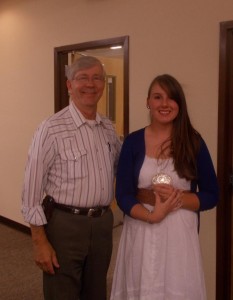
Pictured Above- Terry S., Okaloosa County 4-H Association President, and Morgan S., Senior Horseman of the Year Award Winner.
Recognition is a very important part of life! People of all ages thrive on recognition of any kind. It makes them feel good about themselves and helps build self esteem. This doesn’t mean that every time someone does something GREAT that we throw a party and give them something. Recognition can be something as simple as saying, “Great Job today on your presentation. I could tell that topic meant a lot to you, and I really enjoyed it.” It can absolutely make someone’s day to here that they did a fantastic job.
Recognition is a big part of 4-H. We recognize 4-H’ers for showing exceptional character, completing projects, and participation in events and competitions. By recognizing one person, we are not putting others down. We simply mean to pump everyone up so that they feel successful in what they have done. It is very important to build kids up when they are young, so that they feel as if they can conquer the world. To be honest, if they set their minds to it, they can conquer the world! Florida 4-H is a program where kids can experience things they would normally never do, find new hobbies, make new friends, and gain self confidence. We are here to help them realize that the sky is not the limit but that they can go so far above and beyond, and with a little extrinsic motivation, or recognition, they can reach their most exceptional dreams!
by Whitney Cherry | Jan 18, 2013
 Although we live in the Sunshine State, we still have to deal with a few days of cold weather. When it’s cold out, it can be hard for youth and their parents to get the 60 minutes of daily physical activity recommended by health officials. If families do venture out into the cold to exercise, it is crucial that family members dress appropriately to prevent too much heat loss. Here are a few tips to remember when exercising in cold weather. (more…)
Although we live in the Sunshine State, we still have to deal with a few days of cold weather. When it’s cold out, it can be hard for youth and their parents to get the 60 minutes of daily physical activity recommended by health officials. If families do venture out into the cold to exercise, it is crucial that family members dress appropriately to prevent too much heat loss. Here are a few tips to remember when exercising in cold weather. (more…)
by Suzanne Wilson | Dec 5, 2012
Here are activities to help members get to know each other, break up cliques, and decrease disruptions during meetings.
Birthday Line-up
Have members line up in a straight line by their birth date without talking to each other. Depending on the age of the club members you can make it easy using only the month and day or if you really want to challenge them include their birth year!
Once the line is completed have the youth whisper their birthday to the leader. If anyone is out of order simply announce “Out of Order” and try again. When they get the correct order have them announce their birthdays.
The values of this activity:
– teaching the group to work together
– youth demonstrating leadership
As they end the activity have the line of members fold in half so that the youngest is standing next to the oldest, second youngest is next to second oldest, etc. The first pair of members sits down together followed by each succeeding pair.
The 4-H Chant Challenge
As members arrive at your 4-H meeting, randomly put them in groups of 3 to 6. While waiting for others to arrive, these groups work independently to create a 4-H chant, song, or rap. Tunes for the chants can be offered such as “Call Me Maybe” (Carly Rae Jepson), “We’re All in This Together” (High School Musical), “Mary Had a Little Lamb” (Nursery Rhymes), and “We Will Rock You.” You may select songs that your group is familiar with or let them select their own.
The goal is to create lyrics to share how great 4-H is for kids and families. Through the process, the club members will connect and have a great time. Actions to the lyrics are welcome, too! Don’t forget to include any parents and family members in the groups!
Be sure to have a video camera ready! You won’t want to miss the fun as 4-H members share their chants with the entire club! This can go into a county-wide event for even more fun.
The 4-H Club Pennant Challenge
As clubs grow they develop an identity – help them share what their club is all about! Have the club member’s work together to develop their own 4-H Club Pennant – just like sports teams. National 4-H Week is a great time to have 4-H clubs present colorful banners that tell a story about their club. They can be displayed at the county 4-H office – this is a great way for the public to learn and ask questions about the 4-H program. Photos of club banners can be used on Facebook or other web pages as the profile picture.
Material for felt banners or pennants is inexpensive and easy to use with stencils for quality artwork. They can also be done on poster board and laminated. Set guidelines that include proper display and use of 4-H clover and prohibit use of copyrighted or other protected materials. Have a standard size and shape for all clubs that includes enough room for basic information. Be ready for an explosion of creativity!
by Heather Kent | Dec 5, 2012
You may have made your own pH indicator out of red cabbage in science class, but did you know that you can make pH paper out of poinsettias? Many plants contain pigments (special colored cells) that are responsive to changes in pH. You can extract the pigment from red poinsettias to make your own pH paper at home to test whether a liquid is an acid or a base. “pH” stands for potential Hydrogen and is a measure of the acid/alkaline balance of a substance. Scientists use this measurement in a variety of fields to monitor health of humans, plants, and animals. pH is also an important measurement for maintaining our water quality.
Poinsettias are native to Mexico and Central America. In the US, they are used as annual decorative plants for the winter holidays, but they can be grown as a perennial in warmer climates. They are available in a variety of colors ranging from white to deep red. The so-called ‘flowers’ are actually special leaves called bracts; the real flowers are tiny and usually yellow. For more information on how to select and care for poinsettias, visit the UF IFAS Extension website at: http://solutionsforyourlife.ifas.ufl.edu/hot_topics/lawn_and_garden/poinsettias.html#varieties. Note: Poinsettias are in the milkweed family, and some people are sensitive to the milky sap that comes out when you break off a leaf. Be sure to wash your hands after handling the leaves, and do not touch your face, eyes, or mouth while making your pH paper.
To make Poinsettia pH paper, you will need:
- poinsettia bracts
- scissors or a blender
- ½ cup boiling water
- 2 cup liquid measuring cup
- coffee filters
- rubber band
- toothpicks or cotton swabs
- vinegar or lemon juice (an acidic solution to test pH)
- baking soda solution (1 tsp. in one cup of water, a base solution to test pH)
- adult supervision
Cut the bracts into strips or ask a parent to chop them in a blender. Place the cut pieces into measuring cup. Add just enough boiling water to cover the plant material. Allow the solution to steep until the color is removed from the plant (this usually takes 10-20 minutes). Cover a cup with a clean coffee filter and secure with a rubber band. Slowly pour the liquid into the cup, then discard the plant matter. Remove the rubber band and filter paper and discard. Dip a clean coffee filter into the filtered poinsettia solution. Allow the filter paper to dry. You can cut the colored paper with scissors to make pH test strips, or leave the filter whole to use a color change paper. Use a toothpick or cotton swab to apply a little liquid to a filter paper. The color range for acids and bases will depend on the particular plant.
Create your own pH scale by researching the known pH of common house-hold liquid such as vinegar, lemon juice, orange juice, soda, etc. Test each liquid to determine the color the pH level produces; or design an experiment to find out what happens if you dilute the vinegar or baking soda. Does it change the pH?
4-H is the youth development program of UF/IFAS Extension and is available in all 67 counties in Florida. Youth involved in 4-H science programs apply science, engineering, and technology skills to their projects, develop science literacy workforce skills, and pursue education and careers related to science resulting in a workforce that will create a viable economy and communities for Florida. According to the Tufts University Study on Positive Youth Development, 4-H youth are more likely to: Report better grades, higher levels of academic competence, and an elevated level of engagement at school; are nearly two times more likely to plan to go to college; are more likely to pursue future courses or a career in science, engineering, or computer technology; and have higher levels of female involvement in science programs. 4-H is open to all youth, ages 5-18, regardless of gender, race, color, ethnicity, nationality, creed, or disability.
by Sherri Kraeft | Nov 26, 2012
When most of us go to the pantry to make a peanut butter and jelly sandwich, we don’t think about where the ingredients come from. We all know that peanuts go into the peanut butter and grapes and sugar make the jelly, but what about the bread itself?
There are four main ingredients in any basic bread and its uses and variations are endless. Basic bread recipes usually include flour, water, yeast, sugar.
While working with 4-H youth in a cooking project, why not try to encourage them to make their own variation of plain bread and have some fun?
Some of the many varieties you can bake are: French peasant bread, honey wheat bread and Italian loaf. Click on any of the following links to get great bread-baking tips and recipes to use with kids. Who knows, they may come up with a great variety of their own!

As a volunteer, we encourage youth to develop their own ideas and exert their independence by experimenting within the safety of a 4-H Club environment. Here are some other ideas for extensions of a simple bread-baking activity with youth that incorporate the four essential elements:
Mastery – Have a bread tasting contest and incorporate a skill-a-thon with measurements, tools and ingredients from basic breads to fancy, specialty items.
Gennerosity – Youth can have a Bake-A-Thon or Bake Sale and give all proceeds and products to a local shelter, food bank or food ministry. Students can also make gifts of bread and products that they have made for relatives and other club members.
Belonging – Since all youth like to share their creations, make a collage of pictures of everyone baking and sampling their breads to post to a local website, newspaper or social media page. This is also a great way to raise awareness for local 4-H clubs and their activities.
Independence – Allow 4-Hers to visit a local bakery and ask questions about their business model and how they got started. This allows youth to seejobs and careers related to their interests in the community.
Some other resources are:
http://www.bakingmad.com/kids/getting-kids-interested-in-cooking.
http://www.bakingmad.com/recipes/whitebreads
http://www.perishablenews.com/index.php?article=0018522
http://www.bettycrocker.com/tips/bakewithkids
by Allison Meharg | Nov 26, 2012
As we roll from fall into winter, many of us begin pulling out the warm clothes and preparing for some time indoors. We have such beautiful weather along the gulf coast that most of us usually dread the end of summer. However, this time of year doesn’t have to be the end of all the fun! Many of our 4-H clubs have started projects in natural resources. They’re exploring the outdoors through hiking, biking, camping, bird watching, and GIS. This is the perfect time of the year to start off a club project in one of these areas. The weather is perfect and the changing seasons provide a wonderful educational opportunity for youth of all ages to see our native ecosystems. Youth can incorporate science, technology, math, art, and healthy lifestyles into one project. A few examples are listed below:
– Take your members on a hiking trip to a local state park! Members should be divided into groups of 3-5 and provided with a local wildlife guide and some type of device to take photos. Each group will have 45 minutes to find, identify, and photograph 5-10 native animals or plants. The first group back the starting point wins a prize!
– Early winter is perfect for a casual bike ride. Take members out on a local closed bike path and ride a couple miles. To break up the distance, stop at various points along the way to identify native trees, plants, wildlife, or areas where the ecosystems change. Youth can also make their own trail mix or flavored fruit water to take along with them as a healthy alternative to candy bars and soda.
– Provide each member with a strip of different color shades from the paint store. As you hike they should look for the colors in the landscape. As they identify one, have their leader punch a hole in that paint chip. Members will see the wide variety of colors within the native area.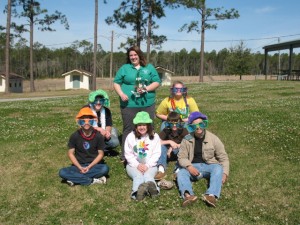
– If your local club or county has GPS units, go on a treasure hunt! Out together These hunts are becoming more popular and a great way to work on direction, map reading, and using technology.
These are just a few of the activities your club could do outdoors. It could be as simple as moving a club meeting to an outdoor area or having a parent/member picnic. The outdoors provide us a great opportunity to build on all types of skills, so don’t miss out: Explore the Outdoors!
by Kay Brown | Nov 26, 2012
Volunteers are the Heart of the 4-H youth program in each of our counties, throughout Florida, and throughout the United States and worldwide. 4-H volunteers truly have the best interest of youth as their major consideration. After several years of working with 4-H volunteers in two different states, volunteers stated their reason for volunteering with 4-H is the joy of watching youth grow and mature into productive young adults. Comments from 4-H agents and volunteers from other states echoed the same reason for being a 4-H Volunteer and for continuing serving in a 4-H volunteer role years after their children were no longer in 4-H. 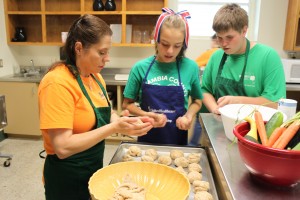
After several volunteer surveys through the years concerning what form of recognition preferred by 4-H volunteers, the number one answer was a thank you from the youth and county 4-H program. Our second top survey answer was a financial scholarship for special 4-H training on a district, state, regional, or national level. We sometimes think we need to lavish our volunteers with special awards, but sometimes just a heartfelt thank you and appreciation for their skills and commitment to the 4-H youth in their club, county, district, and even on the state level.
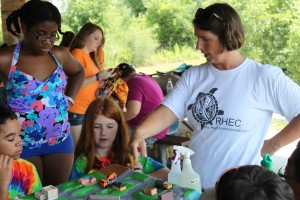 Value and appreciate your 4-H volunteers in your county. Keep them informed and involved of current opportunities for growth and development of their leadership skills. Be sure to design volunteer jobs to fit your volunteer’s special skills, interest, and knowledge. Use creativity when recruiting new 4-H volunteers. Think outside the “norm” for volunteers. There are many retired adults that would love to share their skills with 4-H youth. Look for teachers to share 4-H in the classroom. Look for coaches and physical education resources for healthy lifestyle mentors and/or volunteers. Don’t forget all those other volunteers in your Extension office, Master Gardeners, Home Community Educators, and Master Naturalists.
Value and appreciate your 4-H volunteers in your county. Keep them informed and involved of current opportunities for growth and development of their leadership skills. Be sure to design volunteer jobs to fit your volunteer’s special skills, interest, and knowledge. Use creativity when recruiting new 4-H volunteers. Think outside the “norm” for volunteers. There are many retired adults that would love to share their skills with 4-H youth. Look for teachers to share 4-H in the classroom. Look for coaches and physical education resources for healthy lifestyle mentors and/or volunteers. Don’t forget all those other volunteers in your Extension office, Master Gardeners, Home Community Educators, and Master Naturalists.
One of the great benefits of 4-H is that we can design a volunteer position to fit a volunteers needs and time commitment, from a special interest project of only six hours to a volunteers that continues to serve twenty years after her children graduate from 4-H. 4-H is a place for every child and for every volunteer to grow in a safe environment. Thanks to all our volunteers in the North West District. 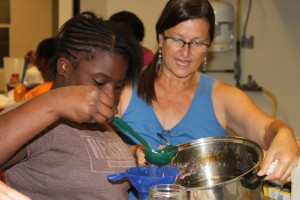
Kay D Brown
Escambia County
kdb@ufl.edu
850-475-5230










